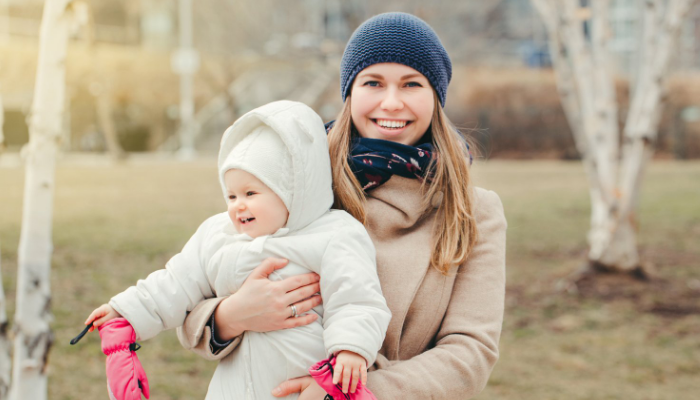5 Things You Need To Know About Keeping Your Baby Warm This Winter
For many mamas out there, this will be the first winter with your little one! It is such an exciting time, but changing temperatures can make it a little tricky to know how to keep your baby at the right temperature!
You might have heard the general rule of thumb that your baby should wear one more layer than you — and that’s kind of true — but it’s a little bit more complicated than that. Don’t worry, we’re sharing 5 things you need to know about keeping baby warm this winter.
Keep an eye out in the next few weeks for more seasonal advice, recipes, and tips!
The ideal temperature for baby is be between 97.9°F to 99°F
To start with, it’s a good idea to understand what temperature your baby should be if they are feeling well. The average body temperature for babies and children ranges from 97.9°F (36.6°C) to 99°F (37.2°C), that’s slightly warmer on average than adults.
How to check your baby’s temperature without a thermometer
Knowing how to check your baby’s temperature without using a thermometer can really help you understand if they are warm enough or not. The best way to check your baby’s temperature is to feel the back of their neck or their chest - they should feel warm, but not hot. Your first instinct might be to check their hands or feet but these aren’t a good indicator of your baby’s temperature as they are usually cooler than the rest of their body - that’s perfectly normal and doesn’t necessarily mean they are too cold.
Signs your baby is too hot:
The skin on the back of their neck or chest is hot
They are clammy or sweaty
Signs your baby is too cold:
They may look pale in the face
Their lips might be blue
They may be irritable or not feeding well
They may be less active than normal
Make the most of layers to keep baby at the right temperature
When you take your baby outside during the winter, they usually need to be wearing at least as many layers as you are. Layers being the keyword here! If you are going to be switching from indoors to outdoors, then it’s a good idea for your baby to wear lots of light layers that you can take on and off as needed.
It’s also important to cover your baby’s head and hands when they are outside in cold temperatures, so wrap them up in a warm hat and mittens. If they won’t keep their mittens on (which they often won’t!) then try tucking their hands under a blanket. Remember, their hats and mittens should be taken off once you’re back inside.
The ideal temperature for baby’s room is between 68°F to 72°F
It’s recommended that the temperature of your baby’s room should be between 68°F (20°C) to 72°F (22°C) regardless of the season.
It can be difficult to judge the temperature of a room, so you can check by keeping a thermometer in the room where the baby sleeps. Using a thermometer helps you determine what clothes your baby should be sleeping in (see more on this below!) and can really help give you peace of mind that your baby is sleeping safely and not overheating.
We recommend: LittleHippo’s Kelvin Color Changing Nursery Night Light, Customizable Room Thermometer, and Hygrometer
Don’t overdress your baby when they are sleeping
If the temperature of your baby’s room falls between the recommended 68°F to 72°F, then start by dressing your baby in a footed sleepsuit under a sleep-sack or swaddle. Remember though, this is a starting point and every baby is different, it’s still important to check their temperature regularly and lookout for signs that they might not be comfortable. If your baby’s room is slightly above or below the recommended temperature then their layers should be adjusted accordingly.
Remember, your baby should not wear a hat when they are asleep indoors. A baby regulates their temperature by releasing heat through their head (clever little things!), so having a hat on can lead to overheating.
According to research, it’s better to have a slightly underdressed sleeping baby than a slightly overdressed sleeping baby as overheating has been linked to a higher risk of Sudden Infant Death Syndrome (SIDS).
Something else you want to know about keeping your baby warm this winter? Heading into a different season you need advice about? Leave us a comment and let us know!

